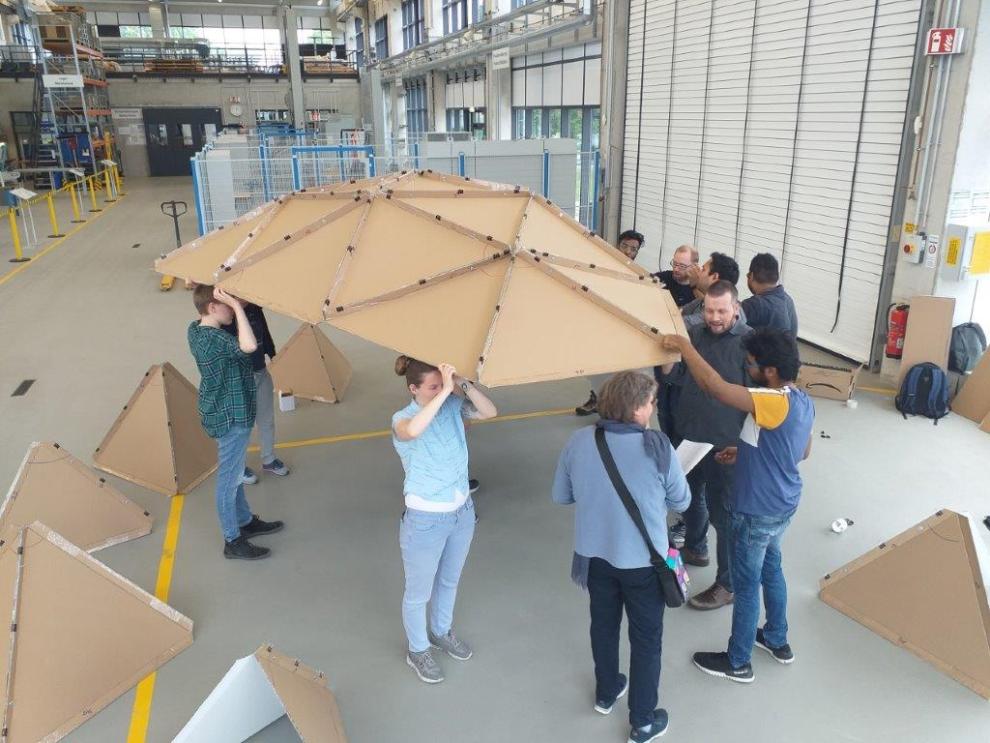Kleve’s First Planetarium Show

"I wish we had a planetarium in our university." said a student.
"That would be so cool," said another student.
"Never mind. We'll make our own!" said the professor.
By: Chetna Krishna
On May 25th 2019, a Planetarium Show was held in Rhine Waal University of Applied Sciences on the occasion of completing 10 years of the university. Actually, not just one but many shows! The 9-minute show was presented back to back in German and English attracting an audience of more than a hundred people. But what if I tell you the Planetarium was all made from cardboard?
In a true DIY spirit, the students of the Astronomy Club and their guiding star Professor Alexander Struck built an entire Planetarium from scratch. From cardboard, 400 clips and 350 screws, to be precise.
Here's a sneak peek of how they made it possible:
Step 1. It's all about Maths
Planning of the magnificent planetarium started with a basic drawing using just a pencil and paper. Thanks to BealsScience.com, students of the Astronomy Club were able to get inspired to make their own Cardboard Planetarium. For the next time, it is a great opportunity for the engineering students of the Astronomy Club to take the project to an advanced level by redefining its shape and dimensions using software such as SolidWorks.
Step 2. Brainstorming
A crucial step to avoid mistakes is to brainstorm before starting the construction work. It is especially important in technical designing. This helped to analyze the real-life ratio that can vary a lot from how it looks on a computer screen.
Later, cardboard was bought from the market that was roughly equal to the area covering the size of half a football field.
The target set was to make a 600 by 300 centimeters dome-shaped Planetarium.
Step 3. Keeping it together
Time for some fun! A pleasant Sunday morning was turned into an Astronomy brunch and a 'Cardboard Cutting' party afterward. A lot of students from various disciplines across the faculties namely Technology and Bionics, Life Sciences and Society and Economics joined the task force to cut and assemble the cardboard in its right position. Hundreds of paper clips and screws were used to keep it together.
Step 4. Almost there!
Building the top dome of the cardboard planetarium was the most challenging part of the construction, despite all the tall people in the team. It required some use of the ladder and a forklift present in the Mechanical lab, where the Planetarium was getting ready for the show on Open Day!
Step 5. Deciding the Show
The next steps to follow were to write the script for the show and choosing the right software to create a short film.
The Astronomy Club created one show in German and one in English for the narration. The speakers of the show were Sabine Hoerkner, a Bioengineering student and Leo Kindred, a Science Communication Intern. While the script was ready with the help of the Astronomy Club students, it was quite a task to time the audio along with the visuals shown with the projector. To this, another member of the club, Konstantin Meixner, a mathematician-turned-Science Communication student, came to the rescue. Using his programming skills, he was able to create a systematic show on Stellarium software. The process involved, for instance, to make sure that the angles of the constellations and other visuals were properly aligned with the wanted position on the Cardboard Planetarium.
Step 6. Become a major hit
The Planetarium Show was revealed on the Open Day held in the campus Kleve on May 25th, 2019. The show was free for all students, staff and the people of Kleve.
The show witnessed a great mix of audiences from kids to young adults to the elderly population. Though different ages, all of them had the same inquisitive mind. What's there behind the cardboard? What does the universe hold?
Some people watched a Planetarium Show for the very first time in life. “Given the fact that it was all self-made, it almost gave the feels of a real planetarium,” said Bhavya Dutta, a student of Mechatronics Systems Engineering.
The audience included some professors too, who had never been in a planetarium before, and were excited to see how the Planetarium Show takes place in the university campus.
The Planetarium turned out to be truly an outcome of great collective efforts. Cooperation was shown by the Marketing Department, Technology and Bionics Faculty and Centre for Research, Innovation and Transfer. The Mechanical Workshops in the university gave a spacious place to the Astronomy Club for days to make the Planetarium Show possible.
A major hit on the Open Day, the Planetarium Show organized by the Astronomy Club was the first time to have happened in the city of Kleve. It became the largest science event at the university that gathered people from many age groups and backgrounds. The astronomical endeavour of students and guidance of Professor Alexander Struck finally paid off.
Text by: Chetna Krishna
Photo by: Konstantin Meixner
